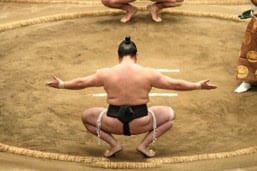 The Sumo Wrestling May Grand Tournament is underway at Tokyo’s Ryogoku Kokugikan right now. The first 3 days of this Grand Tournament in Tokyo took place behind closed doors with no spectators and currently spectators are capped at 5,000 per day, half the usual number, in accordance with government guidelines as a precaution for COVID-19. But there is no shortage of interest in the sport and fans can follow the NHK World broadcasts and comprehensive coverage daily during the tournament.
The Sumo Wrestling May Grand Tournament is underway at Tokyo’s Ryogoku Kokugikan right now. The first 3 days of this Grand Tournament in Tokyo took place behind closed doors with no spectators and currently spectators are capped at 5,000 per day, half the usual number, in accordance with government guidelines as a precaution for COVID-19. But there is no shortage of interest in the sport and fans can follow the NHK World broadcasts and comprehensive coverage daily during the tournament.
Said to have started way back in the Heian period (794-1192), the imperial family watched sumo as a form of entertainment. The sport is steeped in religious ritual and tradition and surrounded by myth and intrigue. Originally staged to entertain the Shinto gods, rules have evolved and developed, but the sumo you see today is very close to the one practiced in the Edo period (1603-1867). Sumo Grand Tournaments take place 6 times a year and 3 of those tournaments are held in Tokyo at the Ryogoku Kokugikan. Each tournament is 15 days long.
With the superhuman sumo wrestlers weighing in at an average of 150kg and standing 185cm tall they attract their fair share of interest. The top ranked wrestlers have celebrity status and serve as cultural ambassadors when they travel overseas.
Sumo Basics:
Sumo takes place inside a ring called a ‘dohyo’. Inside the ‘dohyo’ 2 wrestlers try to force each other out of the ring to win or, make their opponent touch the ground with anything other than the soles of his feet. It is simple, but the more you know about the sport and the technicalities the more you will see.
The top division has 5 ranks with Yokozuna as the very top rank. The most common term for a professional sumo wrestler is Rikishi, meaning powerful man. The Rikishi with the most wins at the end of the tournament is the ultimate winner.
According to the Japan Sumo Association the physical criteria to become sumo wrestler apprentice is to be 167cm or taller and 67kg or heavier (there are other criteria such as completing compulsory education and passing several tests provided by Nihon Sumo Association). There are currently 671 registered wrestlers, divided into 10 ranks according to their ability, belonging to 42 training stables.
More about Sumo:
Beginner’s Guide to Sumo
Japan Sumo Association for Ticket Information and more
For information on the wrestlers, techniques, highlights and to watch the tournament play out visit Japan’s NHK World: https://www3.nhk.or.jp/nhkworld/en/tv/sumo/
Things to do in the Ryogoku Area
Visitors to Tokyo’s Ryogoku can enjoy the downtown atmosphere, here are our top picks of things to do outside the Ryogoku Kokugikan.
1: Delve into the Edo period by visiting Museums (Edo Tokyo Museum and Sumida Hokusai Museum)
2: Try Chanko Nabe the favoured hot pot of the Sumo wrestlers
3. Visit a Sumo stable to watch the practice
4: Experience a traditional art and craft workshop and learn about Tokyo’s cut glass technique known as Edo Kiriko
















